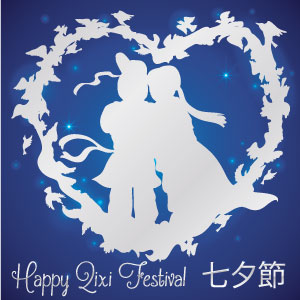Double Seventh Festival
February 11th, 2017

Double Seventh Festival, sometimes known as the Chinese Valentine is an important festival in China. The festival originated from a Chinese mythology about the romantic story between the Weaver Girl and the Cowherd- they were separated by the Milky Way and were only able to meet once a year, on the 7th day of the 7th lunar month.
On the day of Double Seventh Festival, people usually celebrate it by having tangyuan - glutinous riceballs in soup with sweet syrup.
The festival has also inspired other traditional valentine festivals in Japan and Korea, which became today’s Tanabata festival and Chilseok in July.
- Tanabata
- Chilseok
Also known as the star festival, Tanabata shares a similar story with the Folklore of Chinese Valentine. The festival was first introduced by Empress Koken and spreaded among the public in Edo period.
The most popular version of the Tanabata festival features the Weaving Princess, Orihimi and the Cowherd, Kengyuu. Tanabata means weaving machine in Japanese. Orihimi’s father, also called Tentei or King of the Universe, was mad that Orihimi could not continue weaving clothes for him after meeting Kengyuu and he created the milky way to separate the couple. Orihimi kept begging and her tears have finally touched Tentei, who then allowed the couple to meet every 7th of the 7th lunar month if Orihimi works hard to weave clothes.
Japanese usually celebrate this day by writing wishes in the form of poem and hanging them on bamboo. There are also large-scale lantern celebrations inspired by the Chinese Valentine.
Similar to Double Seventh Festival, Chilseok originates from a well known folklore between Jiknyeo and Gyeonwu. They also built a bridge to cross the Milky Way before the 7th of the 7th lunar month, which became a significant symbol of the festival today.
ABOUT THIS PAGE
Psiphon Today is brought to you by Psiphon Inc. Please visit our Privacy Policy, and find out how you can contact us.


